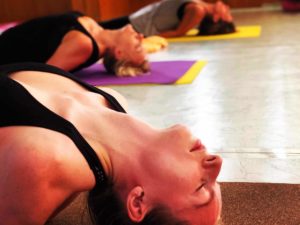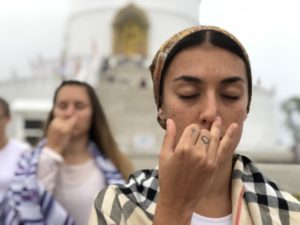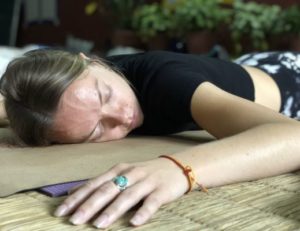Shavasana is a Sanskrit word made of two words: sava means corpse and asana means posture. Savasana (Corpse Pose) is also called mrtasana, as mrt refers to dead in Sanskrit. Often Guided Shavasana relaxation is done at the end of the hatha yoga class. As a relaxed state is prior to Yoga Nidra practice, all Yoga Nidra practices are done in lying down position.
Purpose and benefits of Shavasana
During the Shavasana practice, each part of the body is scanned for joints and muscle tension. Because of this practice, all muscular tension from the body is released. It is a conscious rejuvenation of body, mind, and soul. Therefore, Shavasana helps deepen the breath and reduce stress and tension. Expert yogis can achieve a blissful state during Yoga Nidra practice. You can try this 10 to 15 minutes of daily relaxation practice to calm agitated nerves and overcome fatigue.
Shavasana script
This is a preparation practice for Yoga Nidra. It should be done in a peaceful and dark place where enough fresh air is available.
Please lie down on your Yoga mat in Shavasana. To keep your head slightly supported use a blanket and make sure it is not too high. Let your eyes close gently and if you wish you can cover them with a black cloth. Then, bring your feet apart, keep the heels inward and toes outward. Allow your arms to separate and rest alongside the body, with the back of the hand resting on the ground. Cover your whole body with a warm thin blanket as you might feel cold in relaxation.
Bring your mind’s attention only to the place where you are lying down. Feel the weight of your body on the ground and be aware of your breath flowing through the whole body. Simply by observing your breath it will slow down and allow you to relax deeply in Shavasana.
Guided Shavasana relaxation
Relax your mind.
Relax your forehead. Relax your eyebrows. Relax your eyes.
Relax your nostrils and take a few breaths through the nostrils, slowly and smoothly.
Relax your cheeks. Relax your jaw. Relax the corner of your mouth. Relax your chin. Relax your neck muscles.
Relax your shoulders. Relax your shoulder joints. Relax your upper arms. Relax your elbows. Relax your lower arms. Relax your wrists. Relax your hands. Relax your fingers. Relax your fingertips.
Breathe as though your breath is flowing out of your fingertips taking away all the tensions. Pay attention to the feel of exhalation from the fingertips.
Relax your fingertips. Relax your finger joints. Relax your hands. Relax your wrists. Relax your lower arms. Relax your elbows. Relax your upper arms. Relax your shoulder joints. Relax your shoulders. Relax your throat center. Relax under the armpits and rib cage.
Relax your chest muscles. Relax your cardiac area and gently inhale and exhale.
Relax your stomach. Relax the navel region. Relax the lower abdomen. Relax your thigh joints. Relax your thighs. Relax your shoulder knees. Relax your lower legs. Relax your ankles. Relax your feet.
Relax your toes and breathe as though your whole body is breathing, exhaling out of the toes.
Now, relax each point as you go back up to the forehead again. Remain in Shavasana until you feel completely relaxed and ready to come out.
If you feel to go to sleep please let it happen. Let the brain get the rest it needs. When we don’t get enough sleep brain tries to get it whenever it gets the chance.
Wants to learn more
To learn more Guided Shavasana relaxation, join our Yoga Nidra teacher training in India and Nepal. There, we will guide you through the advanced Shavasana practices during the Yoga Nidra course.
We also offer Online Yoga Nidra Teacher Training Course. You can join in from the comfort of your own home.



